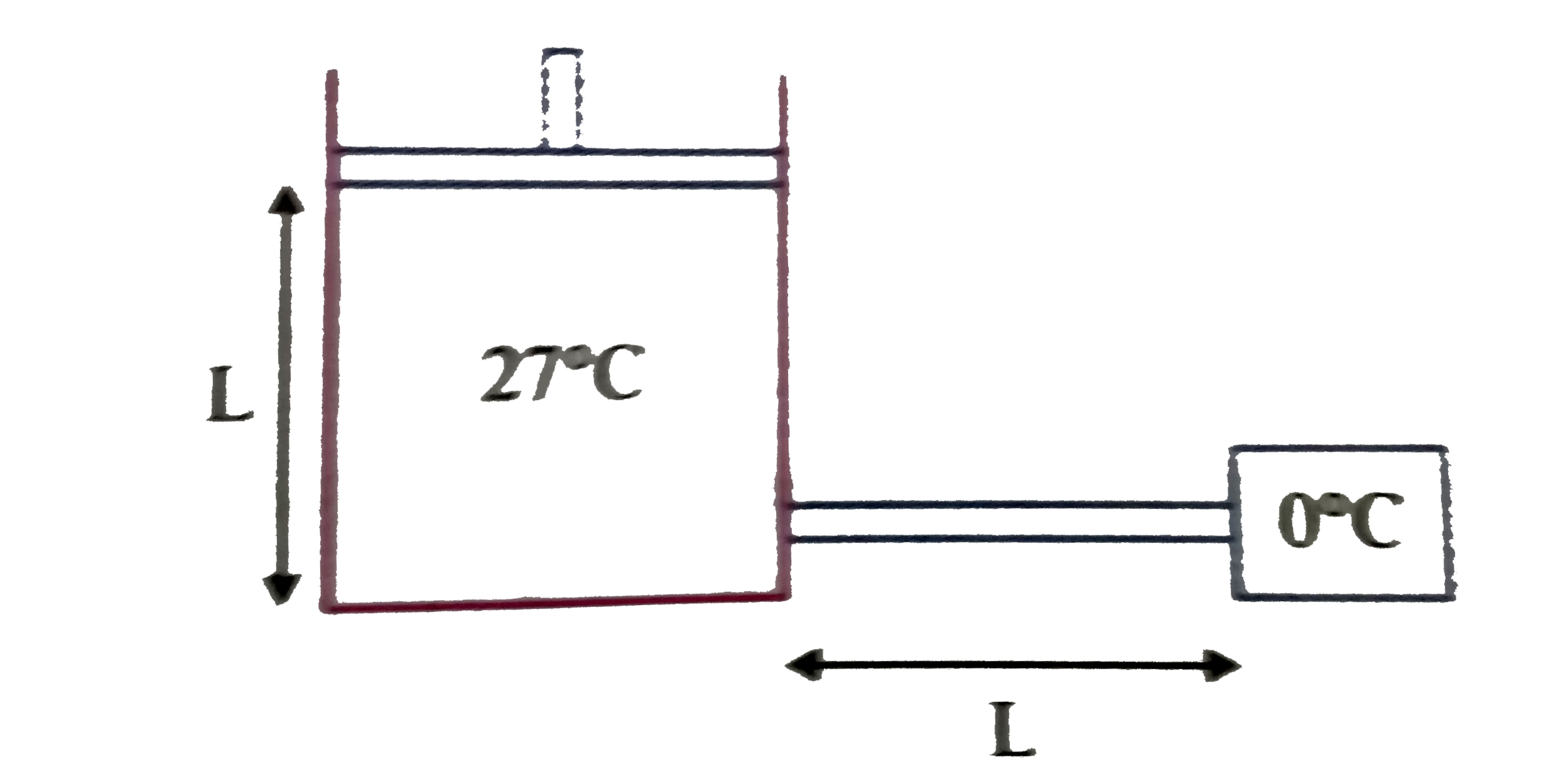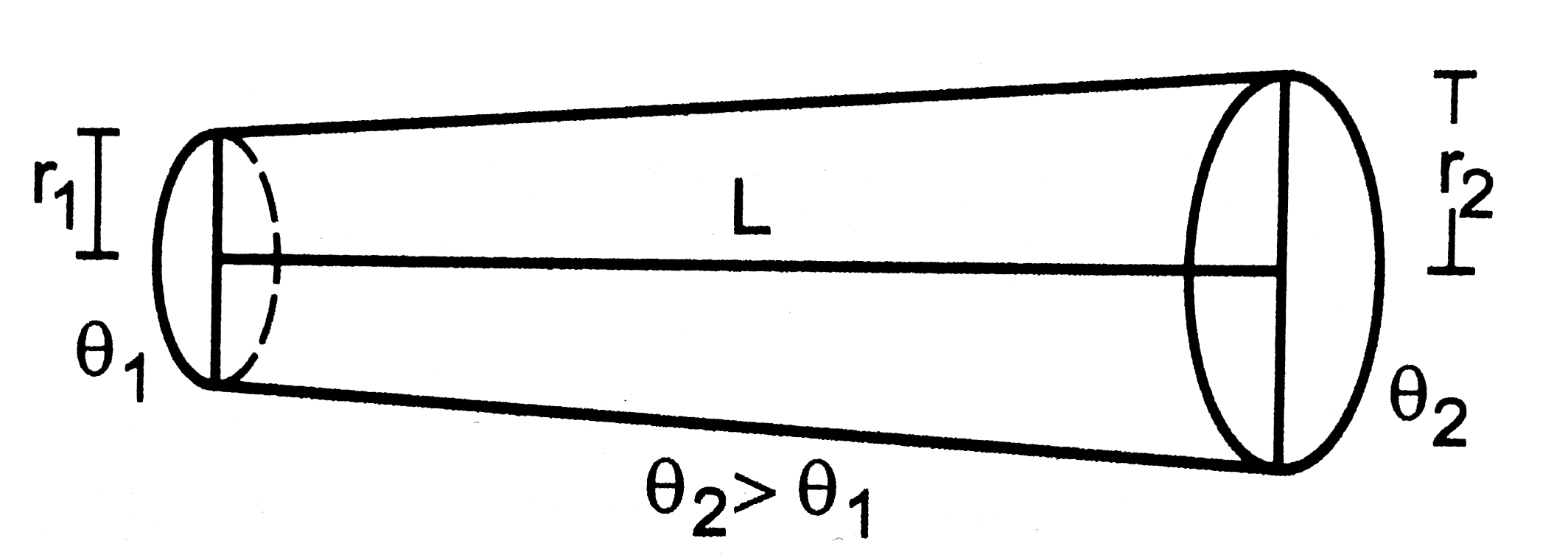0.5 mole of an ideal gas at constant temperature 27∘ C kept inside a cylinder of length L and cross-section area A closed by a massless piston.
The cylinder is attached with a conducting rod of length L, cross-section area (1/9) m2 and thermal conductivity k, whose other end is maintained at 0∘ C. If piston is moved such that rate of heat flow through the conducing rod is constant then velocity of piston when it is at height Z from the bottom of cylinder is : [neglect any kind of heat loss from system]
![0.5 mole of an ideal gas at constant temperature 27^(@) C kept inside a cylinder of length L and cross-section area A closed by a massless piston. The cylinder is attached with a conducting rod of length L, cross-section area (1/9) m^(2) and thermal conductivity k, whose other end is maintained at 0^(@) C. If piston is moved such that rate of heat flow through the conducing rod is constant then velocity of piston when it is at height Z from the bottom of cylinder is : [neglect any kind of heat loss from system]](https://d10lpgp6xz60nq.cloudfront.net/physics_images/DSH_NTA_JEE_MN_PHY_C11_E03_017_Q01.png)
(kR) m/sec
(k10R) m/sec
k100R m/sec
(k1000R) m/sec
The correct Answer is:C
ΔQΔt=ΔWΔt= work done per unit time =kaθL
dWdt=Pdvdt=kaθL,P=nRTV
⇒0.5R(300)AL2A.v=kaθL
k100R
Topper's Solved these Questions
- THERMODYNAMICS BOOK - DISHA PUBLICATIONCHAPTER - THERMODYNAMICS EXERCISE - EXERCISE-1 : CONCEPT BUILDER (Topic-3 CARNOT ENGINE, REFIGERATOR AND SECOND LAW OF THERMODYNAMICS)
15 Videos
- THERMAL PROPERTIES OF MATTER BOOK - DISHA PUBLICATIONCHAPTER - THERMAL PROPERTIES OF MATTER EXERCISE - Exercise-2 (Concept Applicator)
28 Videos
- WAVE OPTICSBOOK - DISHA PUBLICATIONCHAPTER - WAVE OPTICSEXERCISE - EXERCISE-2 : CONCEPT APPLICATOR
30 Videos
Similar Questions
As shownin the figure, 0.5mol of an ideal gas is kept inside an adiabatic cylinder of length L and cross-sectional area A closed by massless adiabatic piston. The cylinder is attached with a conducting rod of length L, crosssectionail area 1900m2 and thermal condactivity 415.5W m^(-1) K^(-1),whoseotherendisma∫a∈edat0^(circ) C.Theπs→nismovedsuchtˆthetemperatureofthegasrema∈sconstantat27^(circ) C.F∈dthevelocity(∈(mm) / (s))oftheπs→nwhenitisatbeightL / 2omthe⊥→mofcyl∈der.(Rodiswelllag≥dandhas¬ligib≤heat∩acity,R=8.31 (Jmol ^(-1) K^(-1) )
'(##CEN_KSR_PHY_JEE_C15_E01_034_Q22##)'
View Solution" A metal rod of area of cross section A has length L and coefficient of thermal conductivity K The thermal resistance of the rod is "
View Solution
Knowledge Check
0.5 mole of an ideal gas at constant temperature 27∘C kept inside a cylinder of length L and cross-section area A closed by a massless piston The cylinder is attached with a conducting rod of length L cross-section area (1/9)m2 and thermal conductivity k whose other end is maintained at 0∘C If piston is moved such that rate of heat flow through the conducing rod is constant then find velocity of piston when it is at height L/2 from the bottom of cylinder [Neglect any kind of heat loss from system
 .A(kR)m/secB(k10R)m/secC(k100R)m/secD(k1000R)m/sec
.A(kR)m/secB(k10R)m/secC(k100R)m/secD(k1000R)m/sec0.5 mole of an ideal gas at constant temperature 27∘C kept inside a cylinder of length L and cross-section area A closed by a massless piston The cylinder is attached with a conducting rod of length L cross-section area (1/9)m2 and thermal conductivity k whise other end is maintained at 0∘C If piston is moved such that rate of heat flow through the conducing rod is constant then find velocity of piston when it is at height L/2 from the bottom of cylinder [Neglect any kind of heat loss from system
 .Ak50RBk100RCk110RDk90R
.Ak50RBk100RCk110RDk90RA metal rod of area of cross section A has length L and coefficient of thermal conductivity K the thermal resistance of the rod is .
ALKABKLLCKALDAKL
Find the rate of heat flow through a cross section of the rod shown in figure (θ2>θ1 . Thermal conductivity of the material of the rod is K.

View SolutionFind the rate of heat flow through a cross section of the rod shown in figure (θ2>θ1) . Thermal conductivity of the material of the rod is K.

View SolutionIf l is the length, A is the area of cross-section and K the thermal conductivity, then the thermal resistance of the block is given by
View SolutionOne end of a metal rod of length 1.0 m and area of cross section 100cm2 is maintained at . 100∘C. If the other end of the rod is maintained at 0∘C , the quantity of heat transmitted through the rod per minute is (Coefficient of thermal conductivity of material of rod =100W/m−K)
View SolutionA metal rod of length 'L' and cross-sectional area 'A' is heated through 'T'∘C What is the force required to prevent the expansion of the rod lengthwise ?
View Solution
